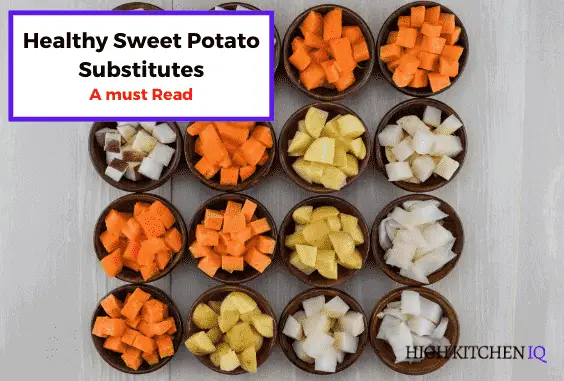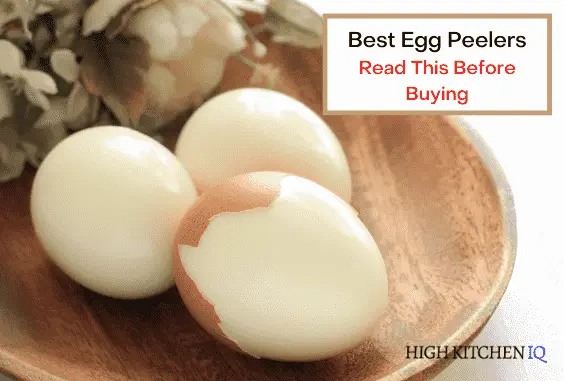19 Best Sweet Potato Substitutes (Healthy & Taste Great)

Sweet potatoes are a superfood and are loaded with lots of essential nutrients, including lots of Vitamin A, B6 &C. They are a tuber/root vegetable and generally have a mild to a strong level of sweetness with a soft, moist texture.
But if you don’t have sweet potatoes in your home or you just don’t like the flavor. Then this article will provide you with other options that can be used as a substitute to replicate the texture and flavor.
These are some of the closest substitutes for sweet potatoes:
- Garnet potatoes (The closest substitute in both taste and texture)
- Jewel potatoes
- Japanese Sweet Potatoes (Healthiest alternative)
- Yukon gold potatoes
- White Potatoes (Budget-friendly and widely available)
- Carrots
- Golden Beets
- Parsnips (Best to eat after winter)
- Taro/ Eddoes
- Cassava/ Yuca
- Ube (Great for desserts and baking)
- Celery Root
- Yams
- Kabocha
- Butternut Squash
- Pumpkin
- Spaghetti squash
- Acorn Squash
- Plantains (A fruit-based substitute)
Included in the list below are lesser-known sweet potato varieties that can imitate the exact flavor and texture of sweet potatoes.
There are also other starchy root vegetables with similar taste and texture to sweet potatoes and lastly other vegetables including some squash and pumpkin varieties that can offer an alternative flavor to that of sweet potatoes.
1. Garnet potatoes (Closest Substitute)
The Garnet Potato is also called the red yam, is the closest substitute for the common sweet potato. Garnet Potatoes are actually a variety of sweet potato but are marketed as “yams” to avoid confusion with the white-fleshed sweet potatoes. So if you can’t find sweet potatoes in your supermarket, try the red yams.
Garnet can be substituted for sweet potatoes in almost any dish and in the same quantity without affecting the flavor of the dish compared to the traditional sweet potatoes.
They have a light red-purplish skin and an orange-yellow flesh that described as being succulent and moist. They have excellent flavor but they are slightly sweeter than a regular sweet potato.
Garnet Potato varieties are a low-calorie, nutrient-dense food, packed with vitamin-A (more than carrots) and high amounts of calcium, fiber, iron, and vitamin-E.
2. Jewel Potatoes
Jewel Potatoes are another variety of sweet potatoes but are commonly referred to as yams. They belong to the “camote” family of potatoes, so they’re perfectly interchangeable with regular sweet potatoes.
The jewel potato is especially great as a substitute for sweet potatoes in traditional baking and casseroles.
They have copper skin and deep-orange flesh that’s moist and tender when cooked. The taste of these potatoes is not as flavorful as traditional sweet potatoes so they may need some seasoning.
Jewel yams are rich in beta-carotene, dietary fiber, vitamin B6, vitamin C, potassium, iron, and calcium.
3. Japanese Sweet Potatoes
Japanese sweet potatoes are called Satsumaimo and are similar to regular sweet potatoes in taste and texture but possess a sweeter taste and softer flesh. These have semi-rough, textured skin that is garnet-colored with a distinct purplish undertone.
There is no limit to how you can cook this potato, as they are very versatile whether roasted, boiled, steamed, or deep-fried, they are always easy to cook. Once cooked, the mildly sweet-flavored soft flesh deepens to a golden, cream-colored hue with a dry, starchy texture.
Japanese sweet potatoes are thought to contain strong anti-aging benefits and a plethora of other essential nutrients including vitamin A, B, C & E, calcium, Magnesium, Iron, potassium, etc.
4. Yukon Gold Potatoes
Sweet and Yukon Gold potatoes are both root vegetables but come from different families. The Yukon Gold Potatoes have golden skin, bright yellow flesh, and a creamy flavor that is not as sweet as sweet potatoes. Yukon Gold can stand up to both dry-heat and wet-heat cooking methods.
Its waxy moist flesh and sweet flavor make it ideal for boiling, baking and frying, but these potatoes will also withstand grilling, pan frying, and roasting. So they are a perfect substitute for any method of cooking for sweet potatoes.
Both types of potatoes are rich in fiber, carbs, and vitamins B6 and C. White potatoes are higher in potassium, whereas sweet potatoes contain more vitamin A.
If you are interested in learning of other substitutes for Yukon Gold Potatoes You can Read This article.
5. White Potatoes
If you can’t find sweet potatoes anywhere and still want the creamy texture in a dish, try white potatoes. The flavor of course will be very different as white potatoes have a neutral flavor.
But You can substitute white potatoes in almost any dish where sweet potatoes may be needed, except soup where white potatoes tend to lose their shape and melt.
While regular and sweet potatoes are comparable in their calorie, protein, and carb content, white potatoes provide more potassium, whereas sweet potatoes are incredibly high in vitamin A.
6. Carrots
Roasted carrots make for a delicious side dish that you can easily swap for sweet potatoes. In fact, they develop a concentrated sweet flavor and caramelized edges when cooked in the oven.
Typically carrots are crunchy and tasty in their raw form and can be shredded and put into many types of salads for a healthier side dish.
Carrots are also found in many colors, including yellow, white, orange, red, and purple which makes them appetizing for the eyes as well and can fool kids that are picky eaters.
Carrots are a root vegetable often claimed to be the perfect health food. They are a particularly good source of beta carotene, fiber, vitamin K1, potassium, and antioxidants.
7. Golden Beets
When raw, Gold beets are crunchy, and when cooked, they develop a tender, smooth, consistency with a very mild and sweet flavor. They can be a substitute for a sweet potato as a side dish as they are delicious boiled or steamed.
The skin of golden beets is orange to yellow in color while the flesh is a bright yellow to gold, dense, with pale concentric rings.
Gold beets are an excellent source of folate, manganese, beta-carotene, and are a very good source of potassium, copper, and fiber. They also contain magnesium, phosphorus, vitamins B6 and C, and iron.
8. Parsnips
The parsnip is a root vegetable that has long, tuberous roots and cream-colored skin and flesh which becomes sweeter in flavor after winter, making January the best time to eat them.
Parsnips usually taste sweeter than carrots and have a nutty aftertaste. Although most recipes feature cooked parsnips, you can also enjoy them raw in salads or coleslaw.
They are rich in nutrients such as fibers, minerals, vitamin C, potassium, and phytonutrients.
9. Eddoes/ Taro
Eddoe commonly called the potato of the tropics is also known as taro, dasheen, or cocoyam. It is grown in exotic nations around the world with its taste similar to that of the potato, but with a nutty flavor and a mild sweetness when cooked.
They can be substituted as sweet potatoes and boiled, roasted, fried or added to homemade breads and puddings.
Eddoe is a starchy edible root vegetable with a brown oblong exterior and a creamy white inside.
It has a significant amount of dietary fiber and carbohydrates, as well as high levels of vitamin A, C, E, vitamin B6, and folate, according to the USDA National Nutrient Database. There is magnesium, iron, zinc, phosphorous, potassium, manganese, and copper in it.
10. Cassava/Yuca
In the United States, cassava is often called yuca and may also be referred to as manioc or Brazilian arrowroot. People can use cassava root as a substitute to sweet potatoes in making side dishes, they are especially good boiled, in soups or as chips.
Cassava is a tuber or root vegetable like sweet potatoes and has a nutty-flavored and a stringy soft texture.
Cassava is a significant source of carbs and also provides a small amount of fiber, vitamins and minerals. It is gluten-free, grain-free and nut-free.
One important note is that cassava root must be cooked before it is eaten. Raw cassava can be poisonous.
11. Ube
Ube is also known as purple yam is essentially a purple sweet potato. They have a mildly sweet, earthy, and nutty taste, reminiscent of regular sweet potatoes or taro. Ube is usually a vivid violet–purple to bright lavender in color, but some range in color from cream to plain white.
They are very trendy in desserts, especially baked goods, and can be substituted for sweet potatoes in other recipes as well.
Ube has a similar nutritional profile to sweet potato, meaning that it’s high in healthy carbs, vitamins, and fiber.
12. Celery Root
Celery root, also known as celeriac, is a versatile root vegetable used for stews, soups, salads and as a substitute for potatoes in a healthy mash. Cooked celery root will develop a sweet taste that is similar to sweet potatoes, but you can also slice it thin and add it raw to your salad for a fresh and nutty taste.
Celery root looks like a roundish bulb approximately the size of a grapefruit. Celeriac is like a root vegetable except it has a bulbous hypocotyl with many small roots attached.
Celeriac is a nutritional powerhouse, packed with fiber and vitamins B6, C and K. It’s also a good source of antioxidants and important minerals, such as phosphorus, potassium, and manganese.
13. Yams
Yams are a type of tuber vegetable that originated in Asia, Africa, and the Caribbean. They’re often mistaken for sweet potatoes. However, yams are less sweet and more starchy.
These delicious tubers can be baked, boiled, steamed, roasted, fried, and pan-cooked. Yams can be enjoyed with or without the skin and used in both sweet and savory dishes.
They have a distinct brown, bark-like exterior. The flesh can be white, yellow, purple, or pink depending on the maturity of the yam.
Yams are packed with fiber, vitamins, and minerals. They’re particularly rich in potassium, manganese, copper, and vitamin C.
14. Kabocha
Kabocha is a hard squash commonly known as Japanese Pumpkin, it has green, slightly bumpy skin, often with light green or white stripes, and dark yellow-orange flesh inside. It also has a fluffy texture similar to chestnut and a sweet flavor that tastes like sweet potato mixed with pumpkin.
It can be used in many of the same ways that you’d use sweet potatoes, including baking, stewed, steaming, and roasting but its flavor is not as sweet so avoid making any pies with them. You can also cut it into thin strips together with onion and corn to make a wonderful side dish for your grilled meat.
It’s packed with beta carotene, iron and vitamin C.
15. Butternut Squash
Both butternut squashes and sweet potatoes are known for their orange hue and creamy texture, so it’s no surprise that they can be substituted for one another in many recipes. Butternut squash also has a sweet nutty flavor similar to that of sweet potatoes.
Butternut squash is delicious when roasted, sautéd, mashed, and toasted and it’s also great for soup.
Butternut squash is rich in Vitamins A, E, C and is a good source of anti-oxidants, Pantothenic Acid, and Phosphorus. While sweet potatoes have more nutrients than butternut squash, they also have twice as many sugars, calories, and carbs.
16. Pumpkins
Pumpkin is a variety of squash with a deep orange color. While the flavor of pumpkin is not as sweet as sweet potatoes, it does have a creamier texture compared to that of sweet potatoes.
While pumpkins can’t be fried into chips like sweet potato, they can be substituted for sweet potatoes in a variety of dishes including side dishes, desserts, soups, salads, preserves, and even as a substitute for butter.
Plus pumpkin is low in calories but rich in vitamins and minerals, all of which are also in its seeds, leaves, and juices. Pumpkin contains proteins, fibers, vitamins (B6, C, E, K), potassium, iron, and thiamin among other things.
17. Spaghetti Squash
Spaghetti Squash is another popular variety of squash . They have a bright yellow color with the flesh being much paler. Spaghetti squash, also has a unique stringy texture once cooked and is quite neutral in flavor.
They can be substituted for sweet potatoes in making casseroles, soups, and salads. There are many cooking methods that can be used to prepare them but the popular ones include baking, roasting, and steaming.
Spaghetti squash is low in calories but rich in vitamins and minerals including vitamin B6, antioxidants, and fiber.
18. Acorn Squash
Acorn Squash is a very versatile squash and can be baked, mashed, roasted, steamed, broiled, or even used in pie recipes.
Acorn Squashes are also often stuffed with rice, meat, or vegetable mixtures, if a sweeter dish is desired, maple syrup is often used to fill the halves prior to baking, or used in a sauce or glaze to enhance the squash’s flavor. The seeds of the squash can also be eaten, usually after being toasted first. Acorn squash can be used to prepare squash soup
So if you are tired of sweet potatoes dishes and want to try something new, experiment with acorn squash recipes plus they can be found in many supermarkets in the USA. This squash is usually green on the outside with a glowing yellow color on the inside.
Acorn squash is rich in nutrients, such as fiber, vitamin C, potassium, and magnesium. It also packs many beneficial plant compounds, including carotenoid antioxidants.
19. Plaintains
Plantains are also known as cooking bananas and are very popular in the tropics. As a staple, plantains are treated in much the same way as regular potatoes as they have a similar neutral flavor and texture. They are incredibly delicious as a side dish with the texture flavor really shinning when steamed, baked, fried, or grilled.
The green plantains have a mild flavor while the ripe ones are very sweet. Green plantains have more starch and less sugar, but as they ripen they turn yellow into black, they slowly become sweeter and more sugary.
Cooked plantains are nutritionally very similar to a regular potato, calorie-wise, but contain more of certain vitamins and minerals. They also compare favorably to sweet potatoes – equally good for you, but containing slightly different nutrients. They’re a rich source of fiber, vitamins A, C, and B-6, and the minerals magnesium and potassium.
Additional Tips to Choosing a Substitute
1. Before choosing your substitute you should take into consideration the recipe you are making and the flavor you want in your dish. Do you want to emulate the flavor of sweet potatoes with another starchy food?. Or are you looking for vegetables with an alternative flavor to sweet potatoes?.
2. Every Substitute is different and not all the substitutes will garner the same results, so only experimentation will find your personal preference. Spend time researching to select the best substitute for you.
3. You should consult with a nutritionist before choosing a sweet potato substitute, especially if you are on a particular diet because not all the replacements can supply the same nutritional values as that of sweet potatoes.
4. In choosing a substitute , it is always better to buy seasonal products to get the best flavor as well as price.





